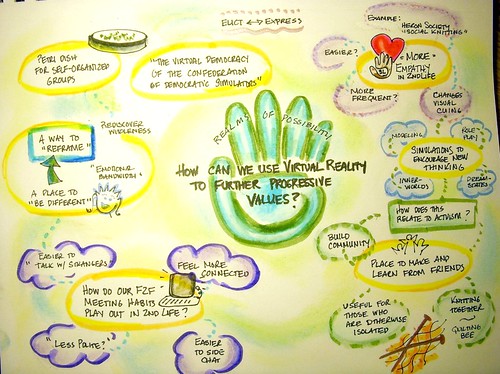Alert: Ramble post coming up…

I wake up this morning at 5am, knowing I have to cram two day’s worth of stuff into today. Tomorrow I head up to Northern Voice in Vancouver, B.C. and today I play hooky for 5 hours to to indulge my love of gardens at the Northwest Flower and Garden Show. I worked/played late last night to experiment with being an in-world graphic recorder in Second Life, stepping away from the computer only after 9pm and having eaten dinner while at the computer. (I RARELY do that.) Oh, and I stayed up too late last night, hooked in to the movie, Michael Clayton.
So there I am, standing at my tiny kitchen counter waiting for the tea water to boil, realizing I had not even looked at yesterday’s paper. I scan the front page of each section and stop when I see this article: Entertainment | Hope Wechkin — physician, violinist, singer, actor in the Seattle Times. A violin playing soprano, actor, physician and head of a pallative care unit?
Integration.
There is something drawing me these days to people and practices that cross traditional boundaries to help us be in, see and experience our work and our worlds in new light. Thus my recent obsession with visual thinking, and graphic facilitation. Why I am leading a session at Northern Voice on “Why I slowed down blogging and started drawing on walls.” Why I think I write more clearly after I practice yoga. I know that brain research has show how we can access more in our brains by having strong connections between the various parts of our brain. But I’m fascinated by how it feels and operates in daily life. I want to explore the impacts of integrating things into my work with online and F2F groups. I want to know how to do it, how to talk about it – with diverse groups so it has meaning to the agricultural researchers and those worrying about building a more compassionate world.
First, a bit about Hope Wechkin, who, as the paper headline says “physician, violinist, singer, actor – doesn’t approach anything halfheartedly.” Hope (I feel compelled to speak of her intimately, not as Dr. Wechkin, for some reason) is currently performing a self written, one woman show here in Seattle, “Charisma.”
A great believer in the power of music, Wechkin says it can “reach beyond words and beyond medicine.” She sometimes brings her violin into the hospice (Evergreen, in Kirkland, is the only inpatient hospice in the region) and plays for patients, watching the effect of music on the body’s different systems and seeing the pleasure the patients feel in what they hear.
In the piece, Hope plays 12 characters. The set is apparently a hospital bed and the costumes a hospital gown and a different pair of shoes for each character. There is a song for each. The play is about the advice others give to a terminally ill patient. Here is what Hope said in the article.
I want musicians to know about this,” she says. “You can get so battered down by the music profession. But I feel the real work is playing not where it is a competition or a job, but where it is transformative, and you can see how it transforms lives.”
Music transforms lives. We can nurture the different parts of ourselves. A picture paints a thousand words. A poem opens up new worlds. A doctor can bring her art into her profession of tending to the end of people’s lives, a time in medicine where she says “I think I have stumbled on a gem in health care. Then end of life puts everything in focus and the important things rise to the surface.”
In this online world of text, the explosion of video and photography has changed the landscape. But our forms are still fairly segmented, separate. What should we be paying attention to in our diverse practices that brings the parts of the brain together, our intellect and our hearts entwined, drawing upon different modalities?
What sort of integration should we be paying attention to?
Photo is link to the Seattle Times by BETTY UDESEN / THE SEATTLE TIMES
If this is improperly linked, folks at Seattle Times, please, let me know. It was such a great photo I wanted to draw people’s attention to it!



